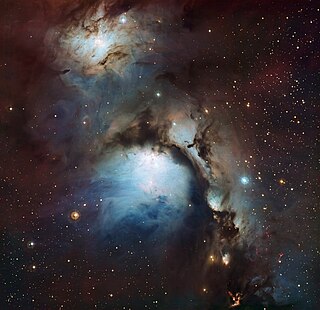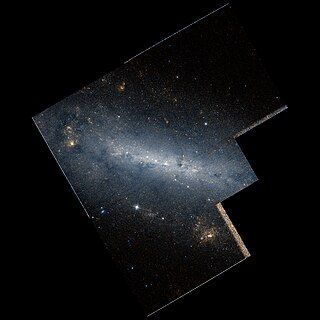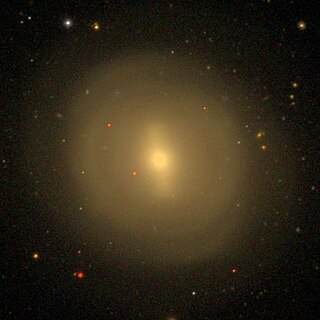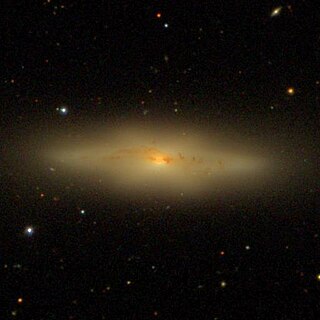
The New General Catalogue of Nebulae and Clusters of Stars is an astronomical catalogue of deep-sky objects compiled by John Louis Emil Dreyer in 1888. The NGC contains 7,840 objects, including galaxies, star clusters and emission nebulae. Dreyer published two supplements to the NGC in 1895 and 1908, known as the Index Catalogues, describing a further 5,386 astronomical objects. Thousands of these objects are best known by their NGC or IC numbers, which remain in widespread use.

Messier 78 or M78, also known as NGC 2068, is a reflection nebula in the constellation Orion. It was discovered by Pierre Méchain in 1780 and included by Charles Messier in his catalog of comet-like objects that same year.

Messier 110, or M110, also known as NGC 205, is a dwarf elliptical galaxy that is a satellite of the Andromeda Galaxy in the Local Group.

Sh2-279 is an HII region and bright nebulae that includes a reflection nebula located in the constellation Orion. It is the northernmost part of the asterism known as Orion's Sword, lying 0.6° north of the Orion Nebula. The reflection nebula embedded in Sh2-279 is popularly known as the Running Man Nebula.

The 2MASX J00482185−2507365 occulting pair is a pair of overlapping spiral galaxies found in the vicinity of NGC 253, the Sculptor Galaxy. Both galaxies are more distant than NGC 253, with the background galaxy, 2MASX J00482185−2507365, lying at redshift z=0.06, about 800 million light-years from Earth, and the foreground galaxy lying between NGC 253 and the background galaxy.

NGC 6342 is a globular cluster located in the constellation Ophiuchus. Its Shapley–Sawyer Concentration Class is IV, and it was discovered by the German-born British astronomer William Herschel on 28 May 1786. It is at a distance of 28,000 light years away from Earth.

NGC 672 is a spiral galaxy in the northern constellation of Triangulum, positioned around 2° to the southwest of the star Alpha Trianguli. The original object designated NGC 672 was discovered by the German-born astronomer William Herschel on 26 October 1786, but this was later cataloged as NGC 614. The object now identified as NGC 672 was discovered by John Herschel on 11 November 1827.

NGC 128 is a lenticular galaxy in the constellation Pisces. It is approximately 190 million light-years from the Sun and has a diameter of about 165,000 light-years.

NGC 6400 is an open cluster located in the constellation Scorpius. It is designated as II2m in the galaxy morphological classification scheme and was discovered by the Scottish astronomer James Dunlop on 13 May 1826. It is at a distance of 3,097 light years away from Earth.

NGC 140 is a spiral galaxy in the constellation of Andromeda. It was discovered by Truman Henry Safford on October 8, 1866.

NGC 254 is a lenticular galaxy located in the constellation Sculptor. It was discovered by John Herschel in 1834. It is in a galaxy group with NGC 134.

NGC 4477 is a barred lenticular galaxy located about 55 million light-years away in the constellation of Coma Berenices. NGC 4477 is classified as a type 2 Seyfert galaxy. The galaxy was discovered by astronomer William Herschel on April 8, 1784. NGC 4477 is a member of Markarian's Chain which forms part of the larger Virgo Cluster.

NGC 4459 is a lenticular galaxy located about 50 million light-years away in the constellation of Coma Berenices. NGC 4459 is also classified as a LINER galaxy. NGC 4459 was discovered by astronomer William Herschel on January 14, 1787. NGC 4459 is a member of the Virgo Cluster.

NGC 4469 is a nearly edge-on spiral galaxy located about 55 million light-years away in the constellation of Virgo. It is also classified as a LINER galaxy. NGC 4469 was discovered by astronomer William Herschel on April 15, 1784. It is a member of the Virgo Cluster.

NGC 5774 is an intermediate spiral galaxy approximately 71 million light-years away from Earth in the constellation of Virgo. It was discovered by Irish engineer Bindon Stoney on April 26, 1851.

NGC 4522 is an edge-on spiral galaxy located about 60 million light-years away within the Virgo Cluster in the constellation Virgo. NGC 4522 is losing its molecular gas though ram-pressure stripping as it plows though the cluster at a speed of more than 10 million kilometres per hour. The galaxy was discovered by astronomer John Herschel on January 18, 1828.

NGC 1310 is a barred spiral galaxy located in the southern constellation of Fornax. It was discovered by English astronomer John Herschel on 22 October 1835.

NGC 694 is a spiral galaxy approximately 136 million light-years away from Earth in the constellation of Aries. It was discovered by German astronomer Heinrich Louis d'Arrest on December 2, 1861 with the 11-inch refractor at Copenhagen.

NGC 4800 is an isolated spiral galaxy in the constellation Canes Venatici, located at a distance of 95 megalight-years from the Milky Way. It was discovered by William Herschel on April 1, 1788. The morphological classification of this galaxy is SA(rs)b, indicating a spiral galaxy with no visual bar at the nucleus (SA), an incomplete ring structure (rs), and moderately-tightly wound spiral arms (b). The galactic plane is inclined to the line of sight by an angle of 43°, and the long axis is oriented along a position angle of 25°. There is a weak bar structure at the nucleus that is visible in the infrared.

NGC 5910 is an elliptical galaxy located about 540 million light-years away in the constellation Serpens. It was discovered by astronomer William Hershel on April 13, 1785. NGC 5910 is also a strong radio source with a conspicuous nuclear jet.




















